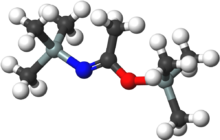Chemistry:Bis(trimethylsilyl)acetamide

| |

| |
| Names | |
|---|---|
| Preferred IUPAC name
Trimethylsilyl N-(trimethylsilyl)ethanecarboximidate | |
| Other names
N,O-Bis(trimethylsilyl)acetamide
| |
| Identifiers | |
3D model (JSmol)
|
|
| Abbreviations | BSA |
| 1306669 | |
| ChemSpider | |
| EC Number |
|
| MeSH | N,O-bis(trimethylsilyl)acetamide |
PubChem CID
|
|
| RTECS number |
|
| UNII | |
| UN number | 2920 |
| |
| |
| Properties | |
| C8H21NOSi2 | |
| Molar mass | 203.432 g·mol−1 |
| Appearance | Liquid |
| Density | 0.832 g cm−3 |
| Melting point | 24 °C (75 °F; 297 K) |
| Boiling point | 71 to 73 °C (160 to 163 °F; 344 to 346 K) at 35mmHg |
| Hazards | |
| GHS pictograms |   
|
| GHS Signal word | Danger |
| H226, H302, H314 | |
| P210, P233, P240, P241, P242, P243, P260, P264, P270, P280, P301+312, P301+330+331, P303+361+353, P304+340, P305+351+338, P310, P321, P330, P363, P370+378, P403+235, P405, P501 | |
| Related compounds | |
Related Amides
|
Dimethylacetamide |
Except where otherwise noted, data are given for materials in their standard state (at 25 °C [77 °F], 100 kPa). | |
| Infobox references | |
Bis(trimethylsilyl)acetamide (BSA) is an organosilicon compound with the formula MeC(OSiMe
3)NSiMe
3 (Me = CH3). It is a colorless liquid that is soluble in diverse organic solvents, but reacts rapidly with moisture and solvents containing OH and NH groups. It is used in analytical chemistry to increase the volatility of analytes, e.g., for gas chromatography.[1] It is also used to introduce the trimethylsilyl protecting group in organic synthesis.[2] A related reagent is N,O-bis(trimethylsilyl)trifluoroacetamide (BSTFA).
Synthesis and reactions
BSA is prepared by treating acetamide with trimethylsilyl chloride in the presence of a base (Me = CH3, Et = C2H5):[2]
- MeC(O)NH
2 + 2 SiMe
3Cl + 2 Et
3N→ MeC(OSiMe
3)NSiMe
3 + 2 Et
3NHCl
The reaction of BSA with alcohols gives the corresponding trimethylsilyl ether, together with acetamide as a byproduct (Me = CH3):[3]
- 2 ROH + MeC(OSiMe
3)NSiMe
3 → MeC(O)NH
2 + 2 ROSiMe
3
References
- ↑ Blau, Karl; J. M. Halket (1993). Handbook of Derivatives for Chromatography (2nd ed.). John Wiley & Sons. ISBN 0-471-92699-X. http://eu.wiley.com/WileyCDA/WileyTitle/productCd-047192699X.html.
- ↑ 2.0 2.1 Harry Heaney, Jian Cui, “N,O-Bis(trimethylsilyl)acetamide” Encyclopedia of Reagents for Organic Synthesis Copyright © 2007 John Wiley & Sons. doi:10.1002/047084289X.rb208.pub2.
- ↑ Young, Steven D.; Buse, Charles T.; Heathcock, Clayton H. (1985). "2-Methyl-2-(Trimethylsiloxy)pentan-3-one". Organic Syntheses 63: 79. doi:10.15227/orgsyn.063.0079.
 |

